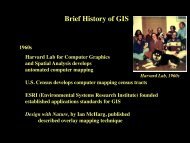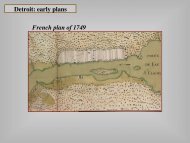You also want an ePaper? Increase the reach of your titles
YUMPU automatically turns print PDFs into web optimized ePapers that Google loves.
<strong>Beijing</strong><br />
and the<br />
<strong>Forbidden</strong> <strong>City</strong>
The northern<br />
capital <br />
<strong>Beijing</strong>
The Great Wall<br />
forms the<br />
northern<br />
boundary <br />
The Great Wall
The Great Wall—<br />
tested<br />
(as depicted by Far Side) <br />
The Great Wall
The <strong>Forbidden</strong> <strong>City</strong> <br />
Birdseye<br />
drawing of<br />
<strong>Forbidden</strong><br />
<strong>City</strong><br />
Bacon, p. 244
The <strong>Forbidden</strong> <strong>City</strong> <br />
“First, the capital should be laid out as a square, surrounded<br />
by a city wall; each side should extend 9 li (1 li = 1/3 mile)<br />
and contain three city gates.<br />
Second, within the city there should be nine longitudinal and<br />
nine latitudinal thoroughfares, each consisting of three<br />
chariot lanes.<br />
Third, in the center of the capital is the Imperial Palace of<br />
the emperor. On the left side of the imperial Palace is the<br />
‘Tai Miao,’ where the emperor pays homage to his<br />
ancestors.<br />
On the right side is the ‘She-ji Tan,’ where he worships the<br />
gods of soil and grain.”
Aerial view of the<br />
<strong>Forbidden</strong> <strong>City</strong> <br />
<strong>Beijing</strong>
The <strong>Forbidden</strong> <strong>City</strong>
The <strong>Forbidden</strong> <strong>City</strong>
The <strong>Forbidden</strong> <strong>City</strong> <br />
One of the gates to<br />
<strong>Forbidden</strong> <strong>City</strong>
The <strong>Forbidden</strong> <strong>City</strong> <br />
Symbolic<br />
names
The <strong>Forbidden</strong> <strong>City</strong> <br />
The Chinese had a codified concept of the ideal city:<br />
- square<br />
- regular<br />
- oriented to the cardinal points<br />
- had left and right sides<br />
- gates at key points<br />
Temples were located at key points:<br />
- east was Altar to the Sun<br />
- west was Altar to the Moon<br />
- south was Temple of Agriculture<br />
and Temple of Heaven<br />
Nothing was on the north side; the barbaric side
The <strong>Forbidden</strong> <strong>City</strong> <br />
The throne
The <strong>Forbidden</strong> <strong>City</strong> <br />
Symbolic<br />
significance<br />
of roofs
The <strong>Forbidden</strong> <strong>City</strong> <br />
View of roofs
The <strong>Forbidden</strong> <strong>City</strong> <br />
A library compound<br />
in the <strong>Forbidden</strong> <strong>City</strong>
The <strong>Forbidden</strong> <strong>City</strong> <br />
Roof details
The <strong>Forbidden</strong> <strong>City</strong> <br />
“Ming <strong>Beijing</strong> is a striking example of the city’s<br />
ability to intensify culture. <strong>Beijing</strong> was a symbolic<br />
world, a whole city built upon the cultural themes<br />
of harmony with nature, security, and power.<br />
Each ‘layer of the onion’ reemphasized the whole<br />
and led to the vital, omnipotent center, the<br />
emperor.<br />
“This particular symbolism probably means little<br />
to us, but we can imagine what it meant to the<br />
Chinese. In a similar manner, out cities transmit<br />
and magnify our culture... What might such<br />
constructions say about what is culturally<br />
important to us?”<br />
Spates and Macionis, p. 196
The <strong>Forbidden</strong> <strong>City</strong> <br />
View Video
The <strong>Forbidden</strong> <strong>City</strong> <br />
Tian-An Men Square<br />
under the emperors
View of square <br />
Tian-an Men Square
Comparison<br />
of traditional<br />
to Communist <br />
Tian-an Men Square
Tian-an Men Square becomes “green” <br />
For the past 50 years Tiananmen Square has been the nearest thing the Chinese<br />
Communist party has had to holy ground. The plaza was created after Mao<br />
Zedong's Communists came to power in 1949. It is the plaza that Mao built,<br />
famed for its rallies during the Cultural Revolution.<br />
Ma Yansong, an award-winning urban planner, says the grey concrete symbol<br />
of China's red politics should be given a green makeover. To heighten<br />
awareness about the environment, he believes the <strong>Beijing</strong> square should be<br />
transformed into a park and forest.
Tian-an Men Square becomes “green” <br />
The architect believes Tiananmen Square need not be considered sacrosanct,<br />
because its origins are relatively recent and foreign. Copying Red Square in<br />
Moscow, it was designed for military parades and giant public rallies. But this<br />
function is, he says, outdated.<br />
However, his plan for Tiananmen is too controversial for the authorities. The<br />
mainland media have already been told not to publish images of his green model.<br />
Said one official, "Tiananmen Square is a sensitive topic because use of this space<br />
for national events. In the long term, I think Tiananmen Square will keep its<br />
original function. ”
<strong>Beijing</strong> Olympics 2008
Density in Hong Kong (Xiangong)
Shanghai, Pudong District
Chinese Mega-<strong>City</strong>
Andrew Armbruster in China
Andrew Armbruster: <br />
Undergrad Symposium
Andrew Armbruster: <br />
Semester in France
Andrew Armbruster: <br />
New town model
These Designs Incorporated<br />
Perennial Philosophies That Emphasized Harmony
The Chinese <strong>City</strong> as a Scroll<br />
Relate Classical Chinese Space to the<br />
Unfolding of a Chinese Scroll Painting
The Chinese <strong>City</strong> as a Scroll
The rationalist European approach<br />
to space is quite different.








